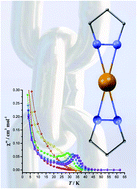Breaking the axiality of pentagonal–bipyramidal dysprosium(iii) single-molecule magnets with pyrazolate ligands†
Abstract
A range of pyrazolate-based ligands have been used to balance the multidentate-chelating feature and the magnetic axiality in “destroyed” pentagonal-bipyramidal (DPB) dysprosium(III) single-molecule magnets (SMMs). This family of complexes are air-stable and share the general formulae of [DyX1X2(Leq)5][BPh4], where X1 and X2 are the anionic axial ligands, including pyrazolate-based ligands and chloride; Leq is the equatorial solvent molecule such as tetrahydrofuran (THF), pyridine (py) and thiazole (NS). Compared to the prototype PB SMMs, the bidentate-chelating features of the pyrazolate ligands show, albeit slow magnetic relaxation behavior, a much smaller energy barrier for magnetization reversal (Ueff). Static electronic calculation shows that the magnetic axiality above the ground mJ = ±15/2 states has been much reduced, leading to the mixing of other states at higher levels. Nevertheless, this systematic study reveals that the variation of the substituents on the pyrazolate ligands and the replacement of planar solvents are effective at influencing the magnetic relaxation behavior. We found that the chloride coordinating mono-pyrazolate complexes, such as [DyX1Cl(THF)5][BPh4] (X1 = 3-(trifluoromethyl)pyrazole (tfpz) 1, X1 = 3-methylpyrazole (Mepz) 2, X1 = 3-isopropyl-1H-pyrazole (Iprpz) 3, X1 = 3,5-dimethylpyrazole (Me2pz) 4, X1 = 3,5-diisopropylpyrazole (Ipr2pz) 5, and X1 = pyrazole (pz) 6, generally show lower Ueff, while bi-pyrazolate complexes, such as [Dy(tfpz)2(THF)5][BPh4] 7, [Dy(pz)2(THF)5][BPh4] 8, [Dy(pz)2(py)5][BPh4]·2py 9 and [Dy(pz)2(NS)5][BPh4] 10, show higher Ueff. Among them, 8 shows the largest Ueff of 521(8) K and a comparable open hysteresis temperature of ∼5 K (at a field sweeping rate of 12 Oe s−1) with 9 and 10. The enhanced blocking temperature for 8 is different from that for the PB Dy(III) SMMs in which the py ligand can cause a much higher hysteresis temperature than the one coordinated with THF due to the aromatic π–π interactions, indicating that the bis-bidentate-chelating Dy(III) ion is rigid enough to reduce the influence from the equatorial ligands. Moreover, substitution with electron-withdrawing groups such as the −CF3 group reduces Ueff prominently. Such a clear magnetostructural correlation in Dy(III) SMMs is fundamentally important, indicating that a subtle balance between magnetic axiality and molecular rigidity is critical to design high-performance Dy(III) SMMs.

- This article is part of the themed collection: Rare Earth Chemistry – In memory of Professor Xu Guangxian at his centenary


 Please wait while we load your content...
Please wait while we load your content...